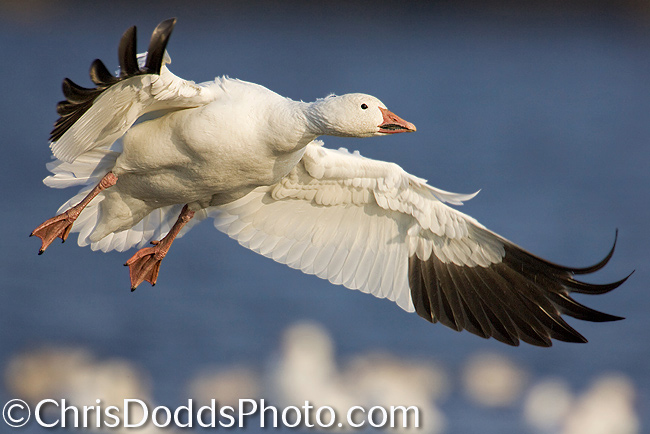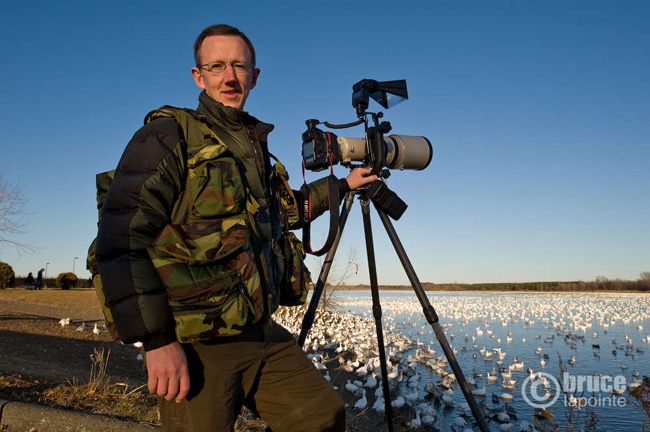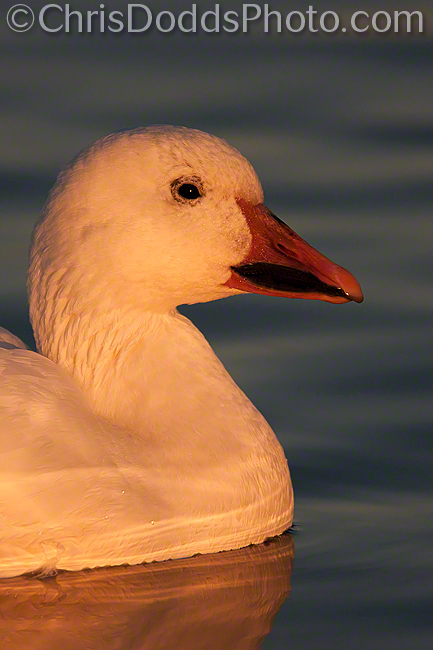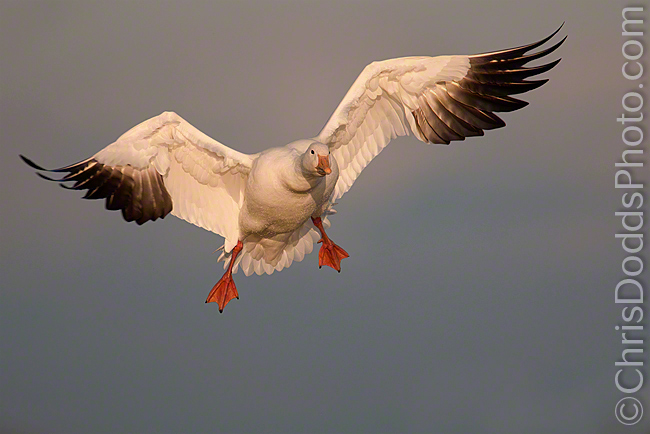 Snow Goose (Chen caerulescens, Oie des neiges) Réservoir Beaudet, Victoriaville, Quebec, Canada. Image Copyright ©Christopher Dodds http://www.chrisdoddsphoto.com All Rights Reserved. Canon EOS 1D Mark III, 500mm F4 IS, 2X II Tele-converter, Gitzo tripod and Wimberley Head II. ISO 320, 1/1250s F8 Manual Exposure. Full Frame. CLICK HERE TO BUY A PRINT or LICENSE AN IMAGE FOR PUBLICATION.
Snow Goose (Chen caerulescens, Oie des neiges) Réservoir Beaudet, Victoriaville, Quebec, Canada. Image Copyright ©Christopher Dodds http://www.chrisdoddsphoto.com All Rights Reserved. Canon EOS 1D Mark III, 500mm F4 IS, 2X II Tele-converter, Gitzo tripod and Wimberley Head II. ISO 320, 1/1250s F8 Manual Exposure. Full Frame. CLICK HERE TO BUY A PRINT or LICENSE AN IMAGE FOR PUBLICATION.
Réservoir Beaudet is immediately adjacent to the city of Victoriaville, in the Eastern Townships of southern Québec. During migration, this site harbours significant numbers of gulls and geese. Since 1996, high numbers of Greater Snow Geese have been recorded here. So far, 224 species of birds have been recorded at this site. The high concentration of waterbirds using the reservoir is probably linked to the absence of hunters. At peak times in October, ducks, geese, and gulls numbers exceed 1000,000 individuals. Several species of land birds also use the reservoir in high numbers for roosting in the fall. The following are some of the peak counts for certain species: 4,000 American Crows (1989), 17,251 European Starlings (1989), 2,500 Red-winged Blackbirds (1988), 1,000 Common Grackles (1988) and 700 Brown-headed Cowbirds (1988).
Photography is relatively easy here; only a short walk from the parking lot is a boat ramp (GPS co-ordinates: 46° 4'6.37"N , 71°58'35.94"W) that is about the best place to be when the wind is from the west in the afternoon. April-May and October-November are the best times of year for photography.
View Larger Map The green arrow indicates the exact location that I like to be in the afternoon when the wind is from the west. GPS co-ordinates are: 46° 4'6.37"N , 71°58'35.94"W
Vested Interest Photo Vests
John Storrie of The Vested Interest (a division of Storrie Parachute Works Inc.) sent me a Khumbu Photography vest and I am thrilled. True to his solid background in building safe, strong and rugged parachutes, John's The Vested Interest produces top quality photo vests. I wanted a vest, but had very specific needs that only John could address. I wanted a way to transport my camera equipment like a backpack, but allow access to camera bodies and lenses while I hiked without removing a backpack, having to lay it down and unzip it, etc.. I chose the Kumbu model because of the large padded pocket on the back that holds either my 500mm F4 IS or my 300 F2.8 IS Canon lenses. I spend a lot of time photographing from a Zodiac, and that large rear "drop-in" lens pouch on the back is perfect even if I were to take the whole kit off; I simply wrap the whole vest around the mast of the flying bridge and secure with the zipper. Unlike a photo-backpack, where the whole contents are at risk of a spill when open, this vest protects all of my gear and still allows access to each component while protecting the rest. I recently took the vest to photograph Snow Geese in Quebec where there are simply too many people to lay equipment down and not worry about it. The vest held everything I needed and still had plenty of room to spare. It's simply a study in astounding build quality, and design genius; there are even brilliantly designed padded shoulders which not only cushion the weight of your shouldered camera, lens and tripod, but they also disperse it. Built of military grade (just about bomb-proof) parachute nylon, this vest will easily outlast me; it's easy to see why the military buy these for their photographers. Be sure to visit The Vested Interest and check out the various vest designs - most of which can be customized to your specific needs.
 That's me, Christopher Dodds, with my Vested Interest Khumbu Photo Vest. Notice just how many pockets there are and that it fits over my down winter jacket. Image copyright & courtesy of Bruce Lapointe.
That's me, Christopher Dodds, with my Vested Interest Khumbu Photo Vest. Notice just how many pockets there are and that it fits over my down winter jacket. Image copyright & courtesy of Bruce Lapointe.
Pro Tip: GET A GRIP!
I often have many thousands of dollars of equipment set-up on my tripod and carry it around on my shoulder while following my subjects around the wilds. From the moment I leave my car, I risk slipping on packed snow or ice. I keep a pair of MICROspikes with me at all times in the winter. It's like having the very best winter tires with studs and chains and is a relatively small investment to protect both myself and my gear. Wether I'm looking for owls in Owl Woods where it is often icy, or just walking my dog, T-Bone; MICROspikes is the product I use. A less expensive product is offered by Yak-Trax, which I used to use until I discovered MICROspikes - both are good, but MICROspikes are more aggressive, robust, long lasting and less likely to get stuck on something and lost.
Comments welcome & appreciated.



 That's me, Christopher Dodds, with my Vested Interest Khumbu Photo Vest. Notice just how many pockets there are and that it fits over my down winter jacket. Image copyright & courtesy of Bruce Lapointe.
That's me, Christopher Dodds, with my Vested Interest Khumbu Photo Vest. Notice just how many pockets there are and that it fits over my down winter jacket. Image copyright & courtesy of Bruce Lapointe.